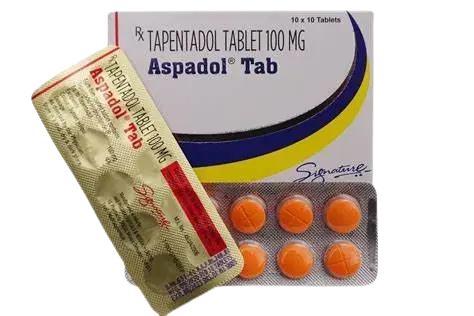Is Tapentadol 100 mg the Right Choice for Your Pain Management Needs?

Chronic pain affects millions of people worldwide, significantly impacting quality of life. When over-the-counter pain relievers fail to provide relief, doctors may prescribe stronger medications like Tapentadol 100 mg. But is this opioid-based drug the right choice for your pain management needs?
In this comprehensive guide, we’ll explore:
- What Tapentadol is and how it works
- Its benefits for different types of pain
- Potential side effects and risks
- Who should (and shouldn’t) use it
- Alternative pain management options
By the end, you’ll have a clear understanding of whether Tapentadol 100 mg is suitable for your condition.
Understanding Tapentadol: A Dual-Action Pain Reliever
Tapentadol is a centrally acting opioid analgesic that stands out due to its dual mechanism of action:
- Mu-Opioid Receptor Agonist – Like traditional opioids (e.g., oxycodone, morphine), it binds to opioid receptors in the brain and spinal cord, reducing pain perception.
- Norepinephrine Reuptake Inhibitor (NRI) – It increases norepinephrine levels, which helps the body block pain signals naturally.
This unique combination makes Tapentadol effective for both nociceptive (tissue-related) and neuropathic (nerve-related) pain, setting it apart from many other opioids.
Common Brand Names & Forms
- Immediate-Release (IR) tablets – Fast-acting, typically taken every 4-6 hours.
- Extended-Release (ER) tablets – Long-lasting, taken once or twice daily for chronic pain.
Tapentadol 100 mg is a moderate to high dose, usually prescribed for moderate to severe pain when lower doses or other medications are ineffective.
Conditions Treated by Tapentadol 100 mg
Doctors may prescribe Tapentadol 100 mg for:
1. Chronic Back Pain
- Effective for degenerative disc disease, spinal stenosis, or herniated discs.
- Provides longer-lasting relief compared to NSAIDs.
2. Neuropathic Pain
- Helps with diabetic neuropathy, sciatica, and post-herpetic neuralgia (shingles pain).
- Unlike pure opioids, its NRI action specifically targets nerve pain.
3. Post-Surgical Pain
- Used after orthopedic surgeries (knee/hip replacements) or major abdominal procedures.
- Reduces reliance on higher-dose opioids like morphine.
4. Osteoarthritis & Rheumatoid Arthritis Pain
- Beneficial for severe joint pain when other treatments fail.
5. Cancer-Related Pain
- Sometimes used in palliative care for pain management in cancer patients.
Benefits of Tapentadol 100 mg Over Other Opioids
While all opioids carry risks, Tapentadol offers some advantages:
Lower Risk of Gastrointestinal Issues
- Traditional opioids (e.g., oxycodone) often cause severe constipation, but Tapentadol has a milder effect on the gut.
Effective for Nerve Pain
- Most opioids only work on inflammatory or injury-related pain, but Tapentadol also helps with burning, tingling, or shooting nerve pain.
Potentially Lower Abuse Risk
- Some studies suggest it has a lower addiction potential than morphine or oxycodone, though it’s still a controlled substance.
Faster Onset & Longer Duration
-
Immediate-release forms work within 30-60 minutes, while extended-release versions provide 12-24 hours of relief.
Potential Side Effects & Risks
Despite its benefits, Tapentadol 100 mg is not without risks. Common side effects include:
1. Mild to Moderate Side Effects
- Drowsiness or dizziness (avoid driving until you know how it affects you).
- Nausea or vomiting (can be reduced by taking with food).
- Constipation (drink plenty of water and increase fiber intake).
- Dry mouth or sweating.
2. Serious Side Effects (Seek Immediate Medical Help)
- Severe drowsiness or confusion (sign of overdose).
- Slow or shallow breathing (respiratory depression).
- Serotonin syndrome (if combined with antidepressants—agitation, fever, rapid heart rate).
- Allergic reactions (rash, swelling, difficulty breathing).
3. Risk of Dependence & Withdrawal
- Like all opioids, long-term use can lead to tolerance, dependence, and withdrawal symptoms (anxiety, sweating, nausea) if stopped abruptly.
Who Should Avoid Tapentadol?
Tapentadol is not safe for everyone. Avoid or use extreme caution if you have:
Respiratory Conditions
- Asthma, COPD, or sleep apnea (opioids can suppress breathing).
Liver or Kidney Disease
- Impaired metabolism can lead to drug buildup and toxicity.
History of Substance Abuse
- High risk of misuse, addiction, or relapse.
Pregnancy & Breastfeeding
- May cause withdrawal in newborns or pass into breast milk.
Concurrent Use of Certain Medications
- Benzodiazepines (Xanax, Valium), alcohol, or sedatives (increases overdose risk).
- MAO inhibitors or SSRIs (risk of serotonin syndrome).
Alternative Pain Management Options
If Tapentadol isn’t suitable, consider:
1. Non-Opioid Medications
- NSAIDs (Ibuprofen, Naproxen) – For inflammation-related pain.
- Acetaminophen (Tylenol) – Mild to moderate pain relief.
- Gabapentin/Pregabalin – For nerve pain.
2. Non-Drug Therapies
- Physical Therapy – Strengthens muscles and improves mobility.
- Acupuncture & Massage – Helps with muscle tension and circulation.
- Cognitive Behavioral Therapy (CBT) – Manages chronic pain perception.
3. Interventional Treatments
- Epidural Steroid Injections – For spinal nerve pain.
- Nerve Blocks – Temporarily numbs pain signals.
4. Lifestyle Changes
- Exercise (Yoga, Swimming) – Reduces stiffness and improves flexibility.
- Anti-Inflammatory Diet – Reduces joint pain (omega-3s, turmeric).
Final Verdict: Is Tapentadol 100 mg Right for You?
Best For:
- Chronic pain patients who haven’t responded to NSAIDs or weaker opioids.
- Neuropathic pain sufferers needing dual-action relief.
- Post-surgical patients requiring short-term strong pain control.
Not Recommended For:
- Those with a history of addiction.
- People with severe respiratory or liver conditions.
- Patients on multiple sedatives or antidepressants.
Consult Your Doctor
Before starting Tapentadol 100 mg, discuss:
- Your full medical history.
- Current medications (to avoid interactions).
- Pain management goals (short-term vs. long-term use).
Conclusion
Tapentadol 100 mg can be a highly effective pain reliever for the right candidate, offering stronger relief with fewer GI side effects than traditional opioids. However, its addiction potential and respiratory risks mean it should be used cautiously and under strict medical supervision.
If you’re considering Tapentadol, weigh the benefits against the risks and explore alternative therapies if needed. Pain management is personal—what works for one person may not work for another.
Have you tried Tapentadol for pain relief? Share your experience in the comments!
Please log in to add a comment.
Dr. James Lawson, a distinguished expert in pain management and pharmaceutical sciences. With over 20 years of medical experience, Dr. Lawson remains deeply committed to advancing safe and effective pain relief solutions. Though no longer in active clinical practice, his passion for healthcare and dedication to patient education continue to thrive. Through his extensive research and medical writing, Dr. Lawson supports our pharmacy’s mission by providing trusted insights on pain management, helping our valued customers make informed health decisions.

.svg)
Delivered in secure, plain packaging on fully tracked delivery from just £20.

Our team of doctors and pharmacists, and our support staff, are all AUS-based.
.svg)
Have a question? Telephone support is always free; Monday - Friday, 9am - 5pm.
